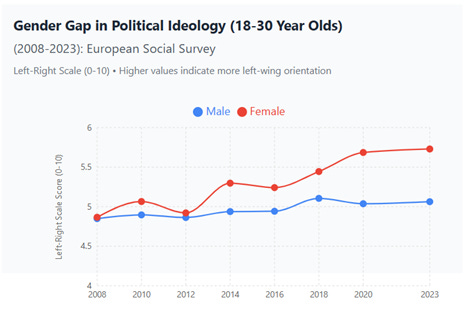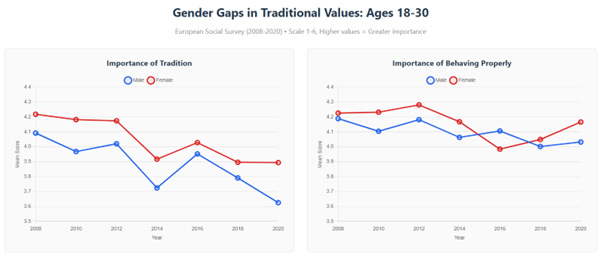Gender trouble
Are young women really more left-liberal than young men?
Increasingly, there are differences in the political values of young men and women. In a viral article which was published last year, the Financial Times journalist John Burn-Murdoch shows that young men tend to be more conservative, whereas young women tend to be more left-liberal. This reverses traditional patterns; historically, women are more conservative than men. Many others are debating this. For example, the KCL academic Alice Evans writes a fascinating Substack called The Great Gender Divergence.
I am very interested in this topic. In our forthcoming book (on pre-order soon!), we find that female gender is one of the key predictors of social justice values. Our work concerns social justice ideology – this is a new ideology which emphasizes identity, emotional safety and anti-capitalist direct action – yet differences in traditional ideologies (i.e. left-right and liberal-traditionalist) are also fascinating. In this piece, I will examine data from the European Social Survey (ESS); this is a large, biennial survey of European countries and I have not seen it used for such analysis.
Changes in the values of young men and women are real enough. Chiefly, these emerge in the ESS’s (self-defined) left-right scale. As we see in the chart below, 18–30-year-old women have become more left-wing in recent years, whereas men of the same age have remained broadly the same. However, self-defined ideology is a problematic measure and individual questions on political attitudes can be more illustrative. Here, the picture becomes rather more ambiguous. Whilst there is a reasonable gap between young men and women in attitudes towards immigration, there is a smaller difference in attitudes towards LGBTQ+ rights; rather than diverging, both groups are becoming more liberal. There is certain diversity between countries – gaps between young men and women do not seem to be as prominent in south-east Europe, potentially reflecting lower levels of socioeconomic development – but national differences are quite limited.
Differences in political attitudes are underpinned by values and, if one examines ESS data on the values of young men and women, things become very interesting. For obvious reasons, conservative ideologies are associated with values such as respect for tradition and conformist behaviour. Contrastingly, left-liberal ideologies are associated with values such as creativity and self-expression. ESS contains a series of question on such values (albeit only until 2020) and I expected that results would reflect trends in self-defined ideology and attitudes.
This is not so. On key values such as the importance of tradition and behaving properly (see chart below), young women are consistently more conservative than young men. Admittedly, this is not the case with other values. In their attitudes towards freedom, fun and following rules, young women have become less conservative, absolutely and (in the case of freedom and fun) compared to young men. As academic literature explains (see below), this may reflect the influence of modernization/the improving social position of women.
Despite these caveats, this paradox is worth exploring. The trend of young women being more politically left-liberal and temperamentally conservative is consistent with arguments which emphasize conformity among left-liberals. There are many internet variants of this point(!), but a recent paper by the political scientist Pippa Norris is most relevant. This finds that, in developed countries with postmaterialist political cultures, the tendency for left-liberals to form overall majorities can entail moral pressure on conservatives. Given this, conformists may have incentives to adopt left-liberal attitudes.
But other ESS data are not consistent with this. If one analyses the responses of European women under 30 at an individual level, left-wing self-identification and liberal attitudes towards immigration and LGBTQ+ rights have small to medium negative correlations with belief in the importance of tradition and behaving properly, i.e. the relationship is as would one expect. In summary, something curious is happening. On the one hand, young European women tend to be more left-liberal than young European men. On the other hand, these women also tend to be more temperamentally conservative (according to some indicators at least). But analysing the individual preferences of young women (i.e. excluding young men), left-liberal attitudes are negatively correlated with temperamentally conservative values.
This may indicate broader stratification within young women. Some may be combining political conservatism and temperamental conservatism (as was the case historically); others might be rejecting both; others might be combining left-liberalism and forms of temperamental conservatism.
Certainly, this suggests that the female embrace of left-liberalism is a distinct phenomenon, rather than a generic adoption of such ideologies. As we emphasize in our book, the prominent female influence on social justice ideology entails emphasis on values such as care and risk-aversion (‘I don’t feel safe!’). Interestingly, we find that females tend to dislike cancellations, potentially reflecting dislike of aggression.
But even with caveats about the types of left-liberal attitudes which women tend to hold, one is still confronted by a causal question; why has the traditional association between women and conservative ideologies inverted? In his article, Burn-Murdoch emphasizes the influence of the #MeToo movement. Notwithstanding the importance of this, it is difficult to attribute such broad trends to a single event.
Academics underline wider factors. According to Inglehart and Norris, modernization has changed the lives of women more profoundly, liberating them from traditional roles. Other scholars emphasize the greater education of women, rise in unmarried women and declining religiosity (traditionally, women are more religious). The ESS has relevant country-level variables such as fertility rate and percentage of women in parliament, but these variables do not reveal anything which academics have not already emphasized.
The endpoint of this trend is far from clear. Given progress in gender equality (and the smaller potential for future gains), will ideological differences between young men and women soon peak? Alternatively, will they deepen and reshape left-liberal ideologies with elements of temperamental conservatism? Future developments should be fascinating and I will return to them on this Substack.




Another good article Thomas!
"On the one hand, young European women tend to be more left-liberal than young European men. On the other hand, these women also tend to be more temperamentally conservative."
I think this also reflects a deeper change that has happened to "liberal" (but actually "progressive") political belief over the last 20 years under the influence of Social Justice ideology. Many formerly strongly progressive positions (e.g. free speech, science-based policy, safeguarding for women and children) have fallen out of favour with progressives and been taken up by conservatives instead (often opportunistically, and sometimes purely of convenience). As a result, it's possible for people to become more "progressive" but actually more objectively conservative in belief.